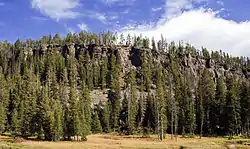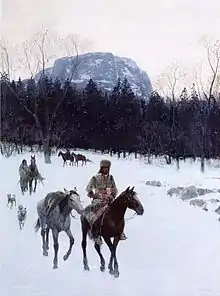Obsidian Cliff
Obsidian Cliff, also known as 48YE433, was an important source of lithic materials for prehistoric peoples in Yellowstone National Park near Mammoth Hot Springs, Wyoming, United States. The cliff was named by Philetus Norris, the second park superintendent in 1878.[4] It was declared a National Historic Landmark in 1996.[1][3]
Obsidian Cliff | |
 Obsidian Cliff | |
  | |
| Nearest city | Mammoth Hot Springs, WY |
|---|---|
| Coordinates | 44.8189°N 110.7278°W |
| Area | 3,580 acres (14.5 km2)[1] |
| NRHP reference No. | 96000973 |
| Significant dates | |
| Added to NRHP | June 19, 1996[2] |
| Designated NHL | June 19, 1996[3] |

The cliff was formed from thick rhyolite lava flow that occurred about 180,000 years ago. The vertical columns are cooling fractures that formed as the thick lava flow cooled and crystallized. The Cliffs stand at an elevation of nearly 7,400 feet (2,300 m) above sea level and go on for about half a mile. The cliffs also extend between 150 and 200 feet above Obsidian Creek. The flow consists of obsidian, a dark volcanic glass. The obsidian is most abundant at the base of the cliff and slowly tapers off to larger concentrations of pumice at the top. Obsidian from this site was first quarried here about 12,000 years ago. Early natives of North America placed a high value on the obsidian that came from this cliff as well as other similar obsidian deposits in the area because numerous tools could be fashioned from obsidian—most popularly, knives, spear/arrow tips, and other sharp-edged objects. In fact, obsidian from Obsidian Cliff was so sought after in early America (before the time of Columbus) that it was traded as far away as Ohio and Canada.
Many studies have been done on the composition of the obsidian from Obsidian Cliff and how the obsidian from Obsidian Cliff was distributed. This research has provided evidence of the direction and extent of prehistoric trade networks.[5]
It is located about 13 miles (21 km) south of Mammoth Hot Springs, on the east side of the Mammoth-Norris section of the Grand Loop Road.[1] The Obsidian Cliff Kiosk, just north, is also listed on the National Register. Obsidian Cliff is also located on the northern end of Beaver Lake in Yellowstone National Park.
Notes
- Ann M. Johnson; Leslie B. Davis & Stephen A. Aaberg (January 28, 1993). "National Historic Landmark Nomination: Obsidian Cliff" (pdf). National Park Service. Cite journal requires
|journal=(help) and Accompanying nine photos, from 1884, 1889, 1920 and 1989 (32 KB) - "National Register Information System". National Register of Historic Places. National Park Service. January 23, 2007.
- "Obsidian Cliff". National Historic Landmark summary listing. National Park Service. Archived from the original on 2006-06-26. Retrieved 2008-02-29.
- Whittlesey, Lee (1988). Yellowstone Place Names. Helena, MT: Montana Historical Society Press. p. 114. ISBN 0-917298-15-2.
- Kenneth P. Cannon (1993). "Paleoindian Use of Obsidian in the Greater Yellowstone Area New evidence of the mobility of early Yellowstone people" (PDF). Yellowstone Science. 1 (4): 6–9. Retrieved 2011-10-15.
External links
 Media related to Obsidian Cliff at Wikimedia Commons
Media related to Obsidian Cliff at Wikimedia Commons- Obsidian Cliff National Historic Landmark at the Wyoming State Historic Preservation Office

